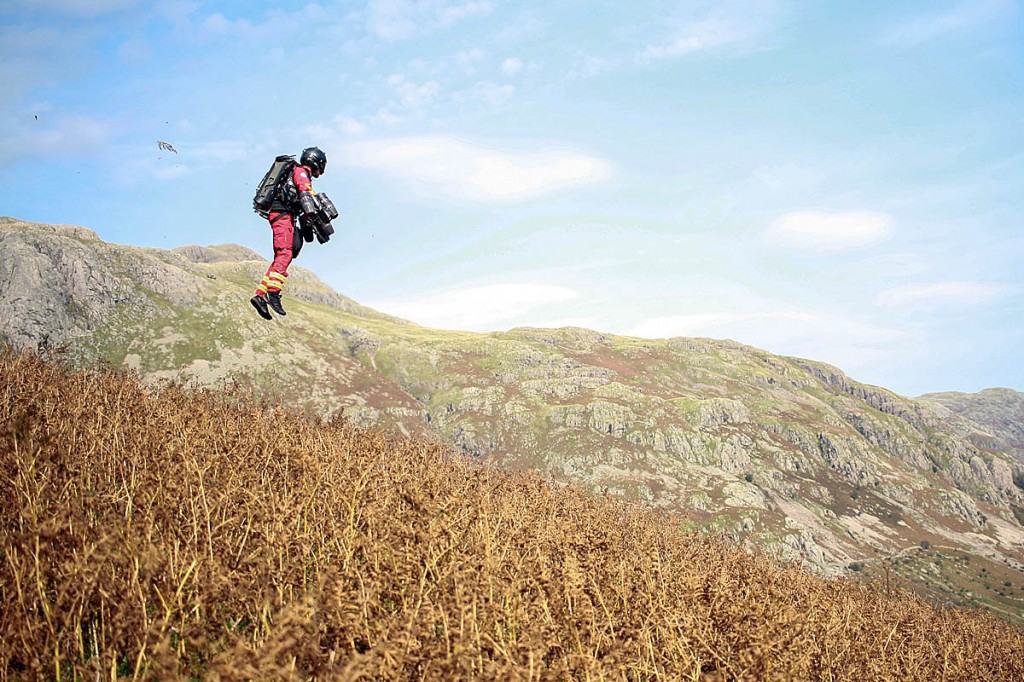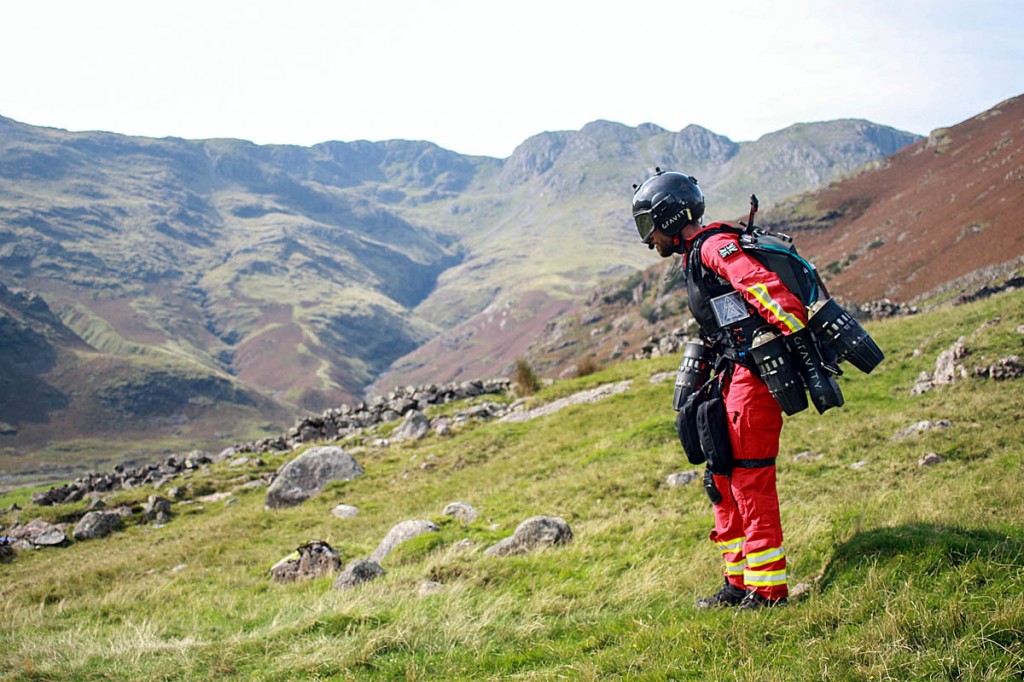Injured Lake District hillwalkers could soon see a futuristic rescuer coming to their aid.
The Great North Air Ambulance Service said a simulated exercise in which a pilot wearing a Jet Suit flew to a ‘casualty’ on the fells was successful.
The co-operation between the medical charity and Gravity Industries could lead to the introduction of the world’s first Jet Suit paramedic in the national park.
Testing of the device, which delivers a 1,050 brake-horsepower downward thrust, enabling its pilot to hover above the ground, was deemed a success.
An initial test flight, in which a Jet Suit and its 30kg of fuel were carried up to Stickle Tarn in Great Langdale, was followed by a simulated callout to an injured girl on The Band, on the flanks of Bow Fell. Gravity’s founder and chief test pilot Richard Browning flew from the valley bottom to the casualty site.
GNAAS said it would normally take rescuers about 25 minutes to reach the site on foot. Mr Browning made the flight in 90 seconds.
The air ambulance charity said the exercise was the culmination of a year of discussion between GNAAS and Gravity Industries.
Andy Mawson, director of operations and paramedic at GNAAS, identified the Lakes as a possible location for a Jet Suit paramedic after hearing of Mr Browning’s work and then studying the charity’s own callout data.
He said: “It showed dozens of patients every month within the complex but relatively small geographical footprint of the Lakes.
“We could see the need. What we didn’t know for sure is how this would work in practice. Well we’ve seen it now and it is, quite honestly, awesome.”
Mr Mawson said the exercise demonstrated the huge potential of utilising Jet Suits to deliver critical care services.
He added: “In a time in healthcare when we are exhausted with Covid and its effects, it’s important to still push the boundaries.
“Our aircraft will remain a vital part of the emergency response in this terrain, as will the fantastic mountain rescue teams. But this is about looking at supplementing those resources with something completely new.
“We think this technology could enable our team to reach some patients much quicker than ever before. In many cases this would ease the patient’s suffering. In some cases, it would save their lives.”
Richard Browning said: “It was wonderful to be invited to explore the capabilities of the Gravity Jet Suit in an emergency response simulation and work alongside the team at GNAAS.
“We are just scratching the surface in terms of what is possible to achieve with our technology. Emergency response is one of the areas Gravity are actively pursuing, alongside launching a new commercial training location at Goodwood Estate.”
The Jet Suit, introduced three years ago, uses five gas turbine engines generating 144kg of thrust to lift a pilot weighing up to 85kg. It uses aviation kerosene or premium diesel fuel to enable a flight of between one and three minutes, although Gravity said this can be extended to up to four minutes in certain conditions.
With the test complete, GNAAS and Gravity Industries said they are now exploring the next steps in this collaboration.
Gravity Industries footage of the Langdale tests.
GNAAS and Gravity Industries expressed thanks Langdale Ambleside Mountain Rescue Team, the National Trust, Stool End Farm and Cumbria Constabulary for enabling the test to take place.


SL
29 September 2020OK, if the technology is there why not try to make use of it.
I'm not saying it's a bad idea but I imagine it'll be pretty useless as well as dangerous in really high winds, driving rain and 20ft visibility.
If conditions were too bad the operator could end up crashing into the grating.
Wainwrightwalker
29 September 2020Again, what's with the grating
Paul
29 September 2020Technology looking for a reason to exist.
OldManOfTheHills
29 September 2020As a first aider, our first guidance is not to increase the number of casualties by becoming one. Helicopters and similar are very vulnerable in stormy weather near mountains particularly low down. And the benighted or stormbound dont need help in ideal flying conditions.
Helicopters if high, can survive engine failure by autorotating the blades and in any event are often twin engined; this jet pack would crash
MR crews are not trained speciality helicopter or jet pack pilots so would still depend on out sourced help to run such kit.
Silly silly idea. 20 drones would give better coverage, and MR members may already have knowledge of them or could easily be taught how to use them.
And if you smack a drone into a crag, you just go fundraising for another couple of hundred quid, not hundred of thousands, and dont have to have the unbearable task of retreiving the mangle corps of a helper
Phil
30 September 2020In good conditions this may have some value, but I can't see it being usable at night, or in poor visibility or in high winds. In other words in the majority of situations when a MR team is going to be called out.
OldManOfTheHills
30 September 2020The price of jet pack is a touch under £450 thousand. The best drones are maybe £1500 and already in use by various folk in harsh environments. They switch between infra red and visible and have optimum height of about 30 to 35m for search, and can also safely deliver radios or torches to casualty without risk to life